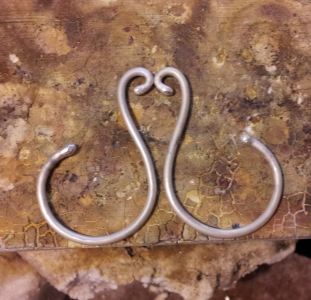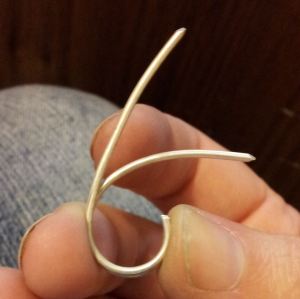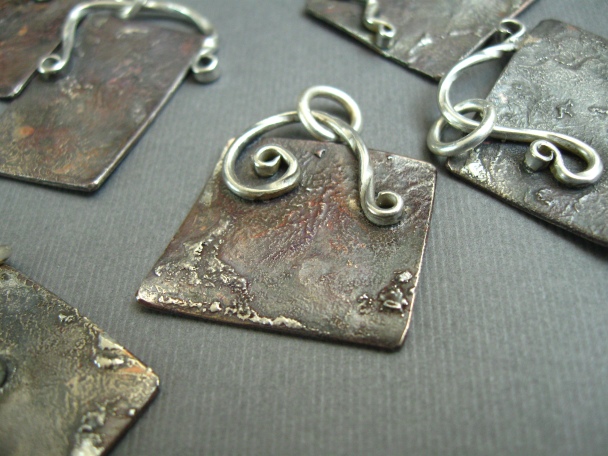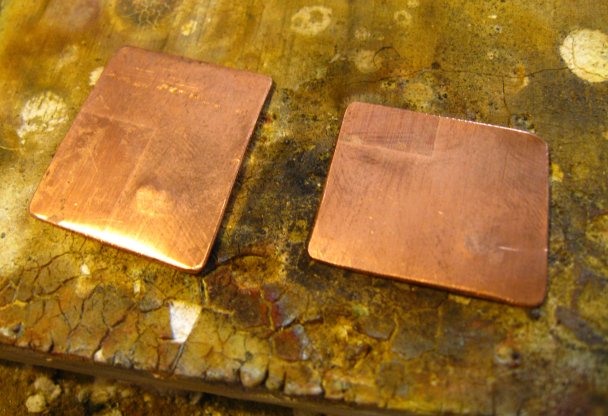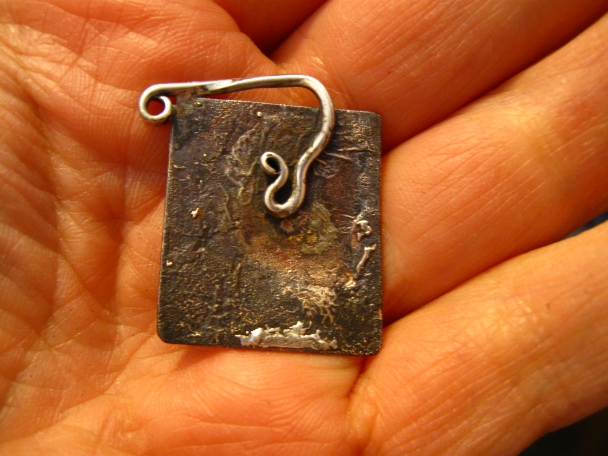My latest obsession is scroll work, like the earrings above. I love swirls and coils, and flowing shapes, and I especially love the challenge of making mirror image pieces. In this tutorial, I’m going to show you a little bit of my process. Specifically, I want to show you how to make scroll shapes using nothing but pliers and your hands, and also how to get nearly perfectly matched pairs of the same shape and size. You know those jigs? The kind with the pegs that you wrap wire around to get certain shapes and sizes? If you have one, put it away. Don’t touch it. You’re going to do this on your own, and here’s where you’ll start: with some sketches.
Ok, no judging my drawing skills, or lack thereof. I don’t usually get too detailed with my drawings, I just use them to try out shapes I’m thinking of, or to get ideas. Also, if you look at the lined paper closely, you might recognize a few of the sketches as earrings that came into being. See the one drawn in blue pen on the overlapping page? That’s what I’m making today.
Once you’ve decided on a design, cut a piece of wire about 1.5 times longer than the desired length of the finished style. A little longer if the finished style will be wide. I don’t really measure. You know the saying ‘measure twice, cut once?’ I like to throw caution to the wind and just eyeball it. Once you have your first piece cut, use it as a guide to cut the second piece. I like to ball the ends of my wires. If you’re going to do this, ball the wire before you cut it. If you cut the lengths and then ball them, you might end up with slightly different lengths. If you’re not going to ball up the ends, just cut them and finish the ends so they’re not sharp. I used 14 gauge sterling silver for my primary shapes.
After your primary pieces are cut and the ends are finished, I recommend annealing and pickling them before you start. If you anneal them, you’ll have a much easier time getting a smooth, even shape that you make by hand.
Now we can start shaping the first wire with pliers or bail makers. Try to remember what size on the bail making pliers you used for what part of the scroll. If you’re using tapered round-nose pliers, make a mark with a sharpie on the pliers where you bent the wire. Notice in the photo below that the wire is not bent tightly around the pliers. This shape is almost completely formed by hand. I use the different sizes on the pliers to prevent the ends from being bigger or smaller than I want. Once the wire is grasped in the pliers, I use my other hand to gently pull the wire into a round, flowing shape. Watch for flat spots and angles, and straighten them out with your hands and pliers as soon as you see them. If the piece becomes work hardened, and you can’t shape it by hand, anneal and pickle it again before continuing. Keep going until you like the shape.
Using the same size on the pliers, start bending the second wire into the same basic shape. Make sure you mark your original shape so that you know which piece you’re working on bending. The piece on the left of the photo is my original piece. I don’t know if you can tell in the photo, but I burnished the top so I could easily tell it was the original. The piece on right is the second shape. I really didn’t do any shaping other than the initial shaping with the pliers. Now that it’s in roughly the same shape as the first, I’m going to show you how to make them the same!
Keeping your original shape on top, hold them up against each other and match them up by the finished ends to check for consistency. See how I have the ends held together between my fingers? It really doesn’t matter which end you choose to start with, just make sure you always use the same end. Meaning, don’t match them up by the other end when you check them the next time. Obviously, there are several spots that need to be adjusted on the piece in back, but now I know exactly where to start. Make little adjustments, and keep checking on your progress by matching them up again.
That looks about right! This is both pieces held together. You almost can’t tell they’re both there. That must mean they’re perfect! No… not quite. We’re going to look at them a couple more ways before we deem them good enough to move on.
Lay them side by side in several different orientations to check for differences. I can see a couple of spots that still need some adjusting in the first photo. Can you? The long part of the shape on the left piece isn’t quite as graceful as the one on the right. In the second photo, I can tell that the right-hand piece needs a little adjusting on the top loop. Make the adjustments that you see, and go through both methods of checking before you move on. Once you’re satisfied, you might want to give them a couple of taps with a hammer to make sure everything is level. I used the flat side of a ball-peen hammer because I wanted to flatten out the balled up ends of the wire a little as well. You can flatten out the pieces as much or as little as you want. I do recommend at least hitting them with a rawhide or rubber mallet just to make sure they’re level. If they’re not, your secondary and detail pieces won’t sit evenly. Once you’ve hit them with the hammer, guess what you have to do? That’s right! Go through the checking methods again to make sure they didn’t get distorted while hammering.
Now we’re going to make the secondary pieces. I used 16 gauge sterling silver wire for this piece. Cut two identical lengths of wire and shape them using the methods above. Place them on the main piece in several places and orientations to decide what you like best. I want them to lay about like they are in the below photo, but this piece still needs some adjustments.
Continue shaping until you get the best fit, and then shape the other piece to match. Don’t worry about making the ends fit just right. You’ll cut off the excess and file it once it’s soldered on.
Remember to hold them against each other to check that the size and shape are the same. Try each secondary piece in each primary piece. You may find that one secondary piece fits better in one primary piece than it does in the other one.
Once you know which secondary piece fits best in which primary piece and they look the same, you can solder them in. I like to use paste solder, but you can use any type of solder you prefer. Some people don’t like to use paste solder, and I can understand why. Unless you pick up the piece and scrape the solder on, it really doesn’t stick to the metal. Once you have your pieces laid out the way you want them, you really don’t want to pick them up and mess that up. Here’s a little trick that might help. Warm your solder board with your torch, then place the piece on the warm spot. The heat will gently transfer to the silver and make it warm. When you touch the solder to the metal, the solder will melt a little, stick to the metal, and get down into the crevices. Don’t heat the piece directly because if it’s heated too much, the flux will burn out of the solder and the solder won’t flow. You can see in the photo that the solder is kind of shiny and creamy, rather than firm and dull. Much easier!
Always solder both sets at the same time. Lay them out side by side, in opposite directions. This helps you to maintain a visual balance so you know you’re soldering each piece symmetrically with the other. Also, make sure that the side you solder them on right now is the side you solder them on every time you add a piece. This will keep everything flush on one side, even if you use thinner gauges of wire, and it will make sure you only have one side to clean up.
Once they are soldered, you can use your flush cutters to cut off any excess from the ends. Cutting at an angle will help you smooth it out. Be careful not to cut into the primary piece, and don’t cut too far down into the solder join.
If you can fit a file into the area, taper down the cut with a file. If the space around it is too small for a file, use a sanding bit on the flexshaft. Don’t file into the primary shape, or you’ll get an ugly little divot. You can smooth out the file marks with a fiber wheel.
Ok, now we’re going to add the details. Obviously, you’re going to use the same steps that you have thus far, with one change. Many times in my designs, the detail pieces require fitting the end into a crevice created by other pieces joining. Here’s how I do that, after I’ve made the shape for the space I want. If the wire is too long for the crevice, place it where you want it, and gently pick it up with your flush cutters, right where you want to cut it. Don’t cut it while it’s laying on your piece because you might cut or mar the finished piece. Once you have the length you like, file the ends down to a point on both sides to give a tighter fit.
Continue with all of the steps until you feel like it’s done. You can add bezel cups for stones and earring backs, but make sure you do that last. Here are my finished earrings! Now let’s see yours 🙂








